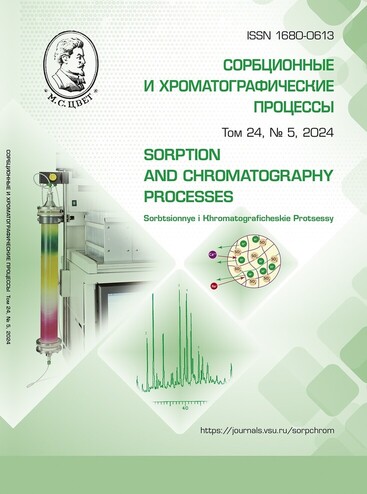A critical review of methods for the determination of dead time (volume)
Abstract
The critical review examines currently known methods for determining dead time, which are required for calculating retention factors and related patterns in chromatography. Particularly remarkable is the fact that the retention factor, determined using the theoretical plate method in relation to chromatography, initially on sorbents that did not have pores, could be converted into a retention factor on porous sorbents, characterised by the presence of mobile phase components in stagnant zones, specifically in the pores of the sorbent. However, the zone of unretained sorbent moved slower than the true speed of movement of the mobile phase. The most popular options from those previously proposed were considered, taking into account new experimental data. The possibility of the presence of gallery pores in sorbents called into question the gravimetric method. In addition, the gravimetric method, similar to many others, did not take into account the difference in the retention of solvents sorbed by adsorption or absorption mechanisms. The use of solvents that wet the stationary phase most likely resulted in the penetration of solvent molecules into the graft phase and should result in a dead volume applicable to the absorption mechanism. If the solvent did not wet the stationary phase well, the meaning of the obtained dead volume became uncertain. Calculation of the dead time by the retention of deuterated water was more acceptable for determining the dead time by the retention of substances using the adsorption mechanism, although the results may be overestimated due to the sorption of water on residual silanol groups. The use of deuterated organic solvents for the same purposes raises many questions. The use of inorganic salts as dead volume markers may present not entirely accurate results on exclusion effects, which should be considered in other options as well. The homological series method was also not unconditionally correct for a number of reasons mentioned in the text. The system peak method also could not be unambiguously confirmed, since it may correspond to retention with an indefinite proportion of exclusion effects. Therefore, the problem remains unsolved to date and the development of new special approaches are required.
Downloads
References
Martin A.J.P., Synge R.L.M. A new form of chromatogram employing two liq-uid phases. I. Theory of chromatography. 2. Application to the micro-determination of the higher monoamino-acids in proteins. Biochem J. 1941; 35: 1358-1368. https://doi.org/10.1042/bj0351358
Saifutdinov B.R. On the interrelation between the distribution constant and the retention factor in liquid chromatography. Russ. J. Phys. Chem. 2013; 87: 512-515. https://doi.org/10.1134/S0036024413030266
Krstulovle A.M., Colin H., Guiochon G. Comparison of Methods Used for the Determination of Void Volume in Re-versed-Phase Liquid Chromatography. Anal. Chem. 1982; 54; 2438-2443. https://doi.org/10.1021/ac00251a009
Engelhardt H., Müller H., Dreyer B. Is There a "True" Dead Volume for HPLC Columns? Chromatographia. 1984; 19: 240-245. https://doi.org/10.1007/BF02687745
Rimmer C.A., Simmons C.R., Dorsey J.G. The measurement and meaning of void volumes in reversed-phase liquid chroma-tography. J. Chromatogr. A. 2002; 965: 219-232. https://doi.org/10.1016/S0021-9673(02)00730-6
Tsopelas F., Ochsenkühn-Petropoulou M., Tsantili-Kakoulidou A. Void volume markers in reversed-phase and biomimetic liquid chromatography. J. Chromatogr. A. 2010; 1217: 2847-2854. https://doi.org/10.1016/j.chroma.2010.02.062
Jiang P., Wu D., Lucy C.A. Determi-nation of void volume in normal phase liq-uid chromatography. J. Chromatogr. A. 2014; 1324: 63-70. https://doi.org/10.1016/j.chroma.2013.11.019
Djerki R.A., Laub R.J. Solute Reten-tion in Column Liquid Chromatography: IX. Comparison of Methods of Determina-tion of the Void Volume in Liquid-Liquid Chromatography. J. Liq. Chromatogr. 1987. 10: 1749-1767. https://doi.org/10.1080/01483918708066797
Dorsey J.G., Dill K.A. The Molecular Mechanism of Retention in Reversed-Phase Liquid Chromatography. Chem. Rev. 1989; 89: 331-346. https://doi.org/10.1021/cr00092a005
Deineka V.I., Nguyen A.V., Deineka L.A. Model of a Reversed Phase Grafted on Silica Gel. Russ. J. Phys. Chem. A. 2019; 93: 2490-2493. https://doi.org/10.1134/S0036024419120057
Deineka V.I., Deineka L.A., Saenko I.I., Chulkov A.N. A Float Mechanism of Retention in Reversed-Phase Chromatog-raphy. Russ. J. Phys. Chem. A. 2015; 89: 1300-1304. https://doi.org/10.1134/S0036024415070079
Deineka V.I., Deineka L.A., Sidorov A.N., Saenko I.I., Kostenko M.O. The evaluation of the properties of the solid-phase extraction cartridge sorbents: the role of the «gallery» pores. Sorbtsionnye i khromatograficheskie protsessy. 2016; 16: 624-630. (In Russ.)
Gritti F., Guiochon G. The van Deemter equation: Assumptions, limits, and adjustment to modern high perfor-mance liquid chromatography. J. Chroma-togr. A. 2013; 1302: 1-13. https://doi.org/10.1016/j.chroma.2013.06.032
Dolan J.W. Slow Column Equilibra-tion. LCGC North America. 2015; 33: 102-107.
Devitt N.M., Moran R.E., Godinho J.M., Wagner B.M., Schure M.R. Measur-ing porosities of chromatographic columns utilizing a mass-based total pore-blocking method: Superficially porous particles and pore-blocking critical pressure mechanism. J. Chromatogr. A. 2019; 1595: 117-126. https://doi.org/10.1016/j.chroma.2019.02.045
Deineka V.I. Nekotorye ter-modinamicheskie aspekty povedeniya veshchestv v usloviyah obrashcheno-fazovoj hromatografii. Sorbtsionnye i khromatograficheskie protsessy. 2006; 6: 571-580. (In Russ.)
Yonker C.R., Zwier T.A., Burke M.F. Investigation of stationary phase for-mation for RP-18 using various organic modifiers. J. Chromatogr. 1982; 241: 269-380. https://doi.org/10.1016/S0021-9673(00)81752-5
Kazakevitch Yu.V., Eltekov Yu.A. Thermodynamic Interpretation of the Ca-pacity Factor. Chromatographia. 1988; 25: 965-968. https://doi.org/10.1007/BF02259413
Scott R.P.W., Traiman S. Solute-solvent interactions on the surface of silica gel: III. Multilayer adsorption of water on the surface of silica gel. J. Chromatogr. 1980; 196: 193-205. doi/10.1016/S0021-9673(00)80439-2.
Deineka V.I., Makarevich S.L., Bli-nova I.P., Deineka L.A. Determining the enthalpy of the transfer of anthocyanidins from the mobile phase to the stationary phase during reversed-phase chromatog-raphy on a С18 stationary phase. Sorbtsionnye i khromatograficheskie protsessy. 2022; 22: 386-392. (In Russ.). https://doi.org/10.17308/sorpchrom.2022.22/10565
Tchapla A., Colin H., Guiochon G. Linearity of Homologous Series Retention Plots in Reversed-Phase Liquid Chroma-tography. Anal. Chem. 1984; 56: 621-625. https://doi.org/10.1021/ac00268a007
Fleming P. Column Dead-time De-termination Methods Based on the Iso-thermal Retention-time Behaviour of a Homologous Series in Chromatography. Analyst. 1992; 117: 1553-1557. https://doi.org/10.1039/AN9921701553
Berendsen G.E., Schoenmakers P.J., de Galan L., Vigh G., Varga-puchony Z., Inczédy J. On the Determination of the Hold-Up Time in Reversed Phase Liquid Chromatography. J. Liq. Chrom. 1980; 3: 1669-1686. https://doi.org/10.1080/01483918008064759
Deineka V.I., Staroverov S.M., Va-siyarov G.G., Burzhinskaya T.G., Blinova I.P. Specific Features of the Retention of Lutein Diesters on C16 Stationary Phases with Different Pore Diameters. Russ. J. Phys. Chem. 2023; 97: 1802-1805. https://doi.org/10.1134/S0036024423080034
Deineka V.I., Deineka L.A., Tur-tygin A.V. Method of the relative retention analysis: reversed-phase HPLC of triglycer-ides. Sorbtsionnye i khromatograficheskie protsessy. 2008; 8: 465-477. (In Russ.)
Dolan J.W. Column dead time as di-agnostic tool. LCGC North America. 2014; 32: 24-29.
Nowotnik D.P., Narra R.K. A Com-parison of Methods for the Determination of Dead Time in a Reversed-Phase High-Performance Liquid Chromatography Sys-tem Used for the Measurement of Lipo-philicity. J. Liq. Chromatogr. 1993; 16: 3919-3932, https://doi.org/10.1080/10826079308019677
McCalley D.V. Evaluation of a line-ar free energy relationship for the determi-nation of the column void volume in hy-drophilic interaction chromatography. J. Chromatogr. A. 2021; 1638: 461849. https://doi.org/10.1016/j.chroma.2020.461849
Redón L., Subirats X., Rosés M. Evaluation of Hold-Up Volume Determina-tion Methods and Markers in Hydrophilic Interaction Liquid Chromatography. Mole-cules. 2023; 28: 1372. https://doi.org/10.3390/molecules28031372







